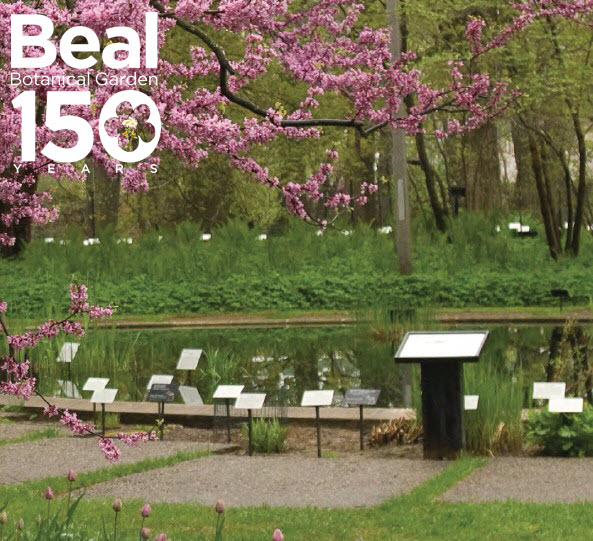Beal Botanical Garden exhibit at MSU Libraries celebrates 150 years of growth on campus and beyond
EAST LANSING, Mich., June 2023 – A new exhibit commemorating the sesquicentennial anniversary of the Beal Botanical Garden is now on display at the Michigan State University Libraries Main Gallery through September 7, 2023.
The exhibit Beal Botanical Garden Sesquicentennial: 150 Years of Research and Accomplishments celebrates the history of the oldest continuously operated university garden in the United States, located on the banks of the Red Cedar River at MSU. A bountiful collection of materials on display honors pioneer botanist William James Beal’s vision of a botanical garden, and visitors will be delighted to see examples of the learning, enjoyment and accomplishments that have grown from it since 1873. The Beal Botanical Garden Sesquicentennial exhibit is curated by a team of MSU Libraries faculty including Forestry and Botany Librarian Suzanne Teghtmeyer, Digital Projects Librarian Andrew Lundeen and University Archives & Historical Collections Archivist Jennie Rankin.
Teghtmeyer expressed admiration for Beal’s efforts, especially those that went into planning the projects that would not bear results until much farther into the future. “W. J. Beal was an energetic man, perfectly placed in time and location,” Teghtmeyer said. “His desire for discovery was endless, as was his enthusiasm for the natural world and how it all fit together. He knew when he was planning the botanical garden, seed viability trial and endless arboretum plantings that he would not be around to see the long-term discoveries they would provide. He planned for future research and studies by students and faculty, and the Beal Botanical Garden has done just that. This library exhibit provides just a small snapshot of the scholarly contributions of Beal Botanical Garden and arboreta to the plant and ecological sciences.”
While the Beal Botanical Garden is known for its diverse collection of flora, much of Beal’s work contributed to the reputation that MSU holds today as a world leader in turfgrass research. The exhibit features Beal’s seminal “Grasses of North America” (1887) as well as former student Macy H. Lapham’s 1899 thesis “Examination of Lawn Grass Mixtures,” which is widely believed to be the first turfgrass research thesis ever written. Other notable pieces in this collection include Beal’s foundational 1904 work, “Michigan Flora: A List of the Fern and Seed Plants Growing Without Cultivation,” and his last official departmental report, “Report of the Department of Botany” (1910), in which he estimates a publication history of 1,286 journal articles, papers, books and reports over his lifetime. This report, as well as many of his other publications, is held by the University Archives, along with Beal’s own records that catalog the bulk of his writings.
Also on display are two seed vitality study bottles on loan from W. J. Beal Botanical Garden & Campus Arboretum. The seed vitality study was initiated by Beal in 1879, which he implemented with the goal of measuring how long certain common seeds could remain dormant in the soil prior to germination. Twenty seed bottles were buried on campus grounds and a bottle was excavated every five years through 1920, at which point the benchmark began progressively shifting to longer intervals in order to extend the study. A 15th bottle was unearthed in 2000 with the 16th planned for 2020 but delayed to 2021 due to the pandemic; the vial from 2000 is on display as well as a 13th bottle excavated in 1970. According to W. J. Beal Botanical Garden & Campus Arboretum Collections Manager Katie Fry, the duration of this experiment outlasted even Beal’s expectations. “Professor Beal did not anticipate his experiment to last nearly this long,” Fry said. “With the final bottle opening in 2100, Professor Beal established a legacy driven by curiosity. His dedication to discovery motivates us to learn more from the plant world. I am excited to see how the next generation of plant biologists advance this study and what new findings are waiting to be unearthed.”
Beal’s work has also advanced into the Age of Technology with the creation of the MSU Campus Tree Map, which came to fruition in 2019. Beginning in the 1990s, former Beal Botanical Garden Curator Frank Telewski used Beal’s records in addition to other primary source materials to populate what is now a virtual map of the entire MSU Campus Arboretum encompassing more than 22,520 trees as of October 2021. In 2022, MSU was one of 410 campuses to be honored with a Tree Campus USA designation from the Arbor Day Foundation. This is the sixth time MSU has received this recognition.
A private donor reception will be held in the gallery space on Sunday, June 25, from 12 p.m. to 1 p.m.
The MSU Libraries are at the center of academic life at Michigan State University, providing expertise, collections and infrastructure for discovery and creation. The Libraries facilitate connections that support research, teaching and learning in our local and global communities. The Libraries also promote equal access to information and spaces for all and lead meaningful initiatives in accessibility, diversity, equity and inclusion.

